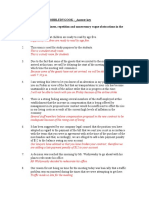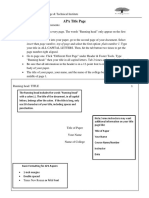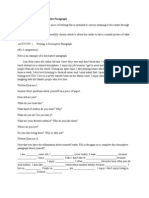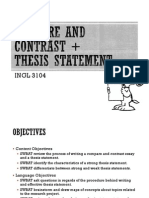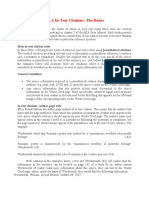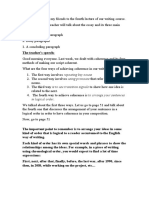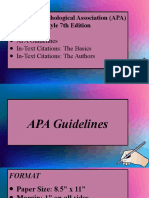0 ratings0% found this document useful (0 votes)
1K viewsParagraph Writing Notes
Paragraph Writing Notes
Uploaded by
swapnil8158This document provides information on paragraphs, including their definition, structure, and development. It defines a paragraph as containing 8-10 sentences that develop a single main idea with unity and are linked with transitions for coherence. It describes the key components of paragraph structure as an introduction, body, and conclusion. The introduction presents the topic, the body provides supporting details, and the conclusion restates the main idea. Different methods for developing paragraphs are also discussed, including inductive, deductive, question-answer, chronological, and compare/contrast orders. Tips for getting started on a paragraph by choosing a topic and generating ideas to support an opinion are also provided.
Copyright:
© All Rights Reserved
Available Formats
Download as DOCX, PDF, TXT or read online from Scribd
Paragraph Writing Notes
Paragraph Writing Notes
Uploaded by
swapnil81580 ratings0% found this document useful (0 votes)
1K views10 pagesThis document provides information on paragraphs, including their definition, structure, and development. It defines a paragraph as containing 8-10 sentences that develop a single main idea with unity and are linked with transitions for coherence. It describes the key components of paragraph structure as an introduction, body, and conclusion. The introduction presents the topic, the body provides supporting details, and the conclusion restates the main idea. Different methods for developing paragraphs are also discussed, including inductive, deductive, question-answer, chronological, and compare/contrast orders. Tips for getting started on a paragraph by choosing a topic and generating ideas to support an opinion are also provided.
Original Description:
ui
Copyright
© © All Rights Reserved
Available Formats
DOCX, PDF, TXT or read online from Scribd
Share this document
Did you find this document useful?
Is this content inappropriate?
This document provides information on paragraphs, including their definition, structure, and development. It defines a paragraph as containing 8-10 sentences that develop a single main idea with unity and are linked with transitions for coherence. It describes the key components of paragraph structure as an introduction, body, and conclusion. The introduction presents the topic, the body provides supporting details, and the conclusion restates the main idea. Different methods for developing paragraphs are also discussed, including inductive, deductive, question-answer, chronological, and compare/contrast orders. Tips for getting started on a paragraph by choosing a topic and generating ideas to support an opinion are also provided.
Copyright:
© All Rights Reserved
Available Formats
Download as DOCX, PDF, TXT or read online from Scribd
Download as docx, pdf, or txt
0 ratings0% found this document useful (0 votes)
1K views10 pagesParagraph Writing Notes
Paragraph Writing Notes
Uploaded by
swapnil8158This document provides information on paragraphs, including their definition, structure, and development. It defines a paragraph as containing 8-10 sentences that develop a single main idea with unity and are linked with transitions for coherence. It describes the key components of paragraph structure as an introduction, body, and conclusion. The introduction presents the topic, the body provides supporting details, and the conclusion restates the main idea. Different methods for developing paragraphs are also discussed, including inductive, deductive, question-answer, chronological, and compare/contrast orders. Tips for getting started on a paragraph by choosing a topic and generating ideas to support an opinion are also provided.
Copyright:
© All Rights Reserved
Available Formats
Download as DOCX, PDF, TXT or read online from Scribd
Download as docx, pdf, or txt
You are on page 1of 10
1.WHAT IS A PARAGRAPH?
Paragraphs are a form of written communication which contains a minimum
of eight to ten sentences. Each sentence in a paragraph "talks about" or develops
one
single main idea. If your paragraph does this, it is said to have unity. In addition,
each sentence in a paragraph must be tied to the one before and after it, like links
in a chain, by using special words called transitions. If your paragraph contains
these links, it is said to have coherence.
EXERCISE 1
Read the paragraph below and then answer the questions that follow.
Riding a bike can give you lots of good exercise every day. I use my bike to get to
work every day. I take my bike to get groceries. When somebody stole my bike, I
was heartbroken, but the police found it two days later. I often ride my bike out to
the country on week-ends just for a change of scene. Without my bike, I wouldnt
get any exercise at all.
1. Does this paragraph have unity? Explain your answer.
2. Does this paragraph have coherence? Explain your answer.
3. What changes would you make to improve this paragraph?
2. PARAGRAPH STRUCTURE
Of course, every good paragraph has to have unity and coherence, but it must
also have structure. an interesting beginning......called an introduction a middle
with specific details.........called the body a satisfying ending.........called the
conclusion.
If you write a paragraph that contains these three sections, you have written a
paragraph with good structure.
2 A. The Introduction
The introduction (one or two sentences) mentions the topic or main idea. In
other words, the writer will tell the reader what he/she is about to be told.
German shepherds are good pets.
The introduction, sometimes called the topic sentence, must also catch the
reader's attention so that he/she will want to finish reading the whole thing. The
sentence above states the topic clearly.
Topic: German shepherds
Main idea: They are good pets.
2 B. The Body
The middle sentences of the paragraph are called the body. This is the part of
the paragraph that develops and supports the main ideas presented in the
introduction. Readers are not likely to be persuaded to change their minds about
something just because someone else says so. They need solid proof and
convincing reasons. Its here, in the body of the paragraph, that the writer can
explain in detail. In other words, now the writer will tell the reader what he/she
really wants to tell.
The body presents supports (convincing reasons) for the writers opinion. Read the
body of the paragraph below and find the reasons the writer uses to support his/her
opinion. Check to see if the supports are convincing and interesting. Also check to
make sure the body has unity and coherence.
First, German shepherds are intelligent. I n addition, they are dedicated to their
owners. Finally, they are usually suspicious of all strangers.
The body of this paragraph contains three reasons to supports the writers opinion
that German shepherds make good pets. Each support is placed in a separate
sentence.
The body of the paragraph has unity because each sentence deals with the topic,
and it contains transitions which give it coherence. Transitions are an essential
part of good paragraph structure. When a writer adds a new idea begins to develop
a new support, he/she often includes a word or phrase to signal the reader that a
new section is about to start. These cues also show the reader how one idea is
logically linked to the next one. Reread the body of the sample paragraph on
German shepherds once more and see if you can find words that act as clues to the
start of each new support and glue the ideas together..
you identified first, in addition, and finally, you have found the three
transitions in this paragraph. Be sure you have put these in the appropriate place in
the notes you are making. These three transitions show the reader that they are part
of a list of supports the writer is presenting.
There are many "cue words" or transitions. Think of some other groups of
words that you could use to get coherence into a paragraph and that will indicate to
the reader that a new support is about to be added to the list of reasons. Here are
just a few of them to get you started.
First,.... Second,..... Third,....
Firstly, ... Secondly,.... Finally
Another reason,.... A final reason
Most importantly....
Addition: furthermore, moreover, too, also, in the second place, again, in addition,
even more, next, further, last, lastly, finally, besides, and, or, nor, first, second,
secondly, etc.
Time: while, immediately, never, after, later, earlier, always, when, soon,
whenever, meanwhile, sometimes, in the meantime, during, afterwards, now, until
now, next, following, once, then, at length, simultaneously, so far, this time,
subsequently
Place: here, there, nearby, beyond, wherever, opposite to, adjacent to, neighboring
on, above, below
Exemplification or Illustration: to illustrate, to demonstrate, specifically, for
instance, as an illustration, e.g., (for example), for example
Comparison: in the same way, by the same token, similarly, in like manner,
likewise, in similar fashion
Contrast: yet, and yet, nevertheless, nonetheless, after all, but, however, though,
otherwise, on the contrary, in contrast, notwithstanding, on the other hand, at the
same time
Clarification: that is to say, in other words, to explain, i.e., (that is), to clarify, to
rephrase it, to put it another way
Cause: because, since, on account of, for that reason
Effect: therefore, consequently, accordingly, thus, hence, as a result
Purpose: in order that, so that, to that end, to this end, for this purpose
Qualification: almost, nearly, probably, never, always, frequently, perhaps, maybe,
although
Intensification: indeed, to repeat, by all means, of course, certainly, without doubt,
yes, no, undoubtedly, in fact, surely, in fact
Concession: to be sure, granted, of course, it is true
Summary: to summarize, in sum, in brief, to sum up, in short, in summary
Conclusion: in conclusion, to conclude, finally
2 C. The Conclusion
The last part of a paragraph is the conclusion. Readers need to know that
they are coming to the end of what they are reading, and they need to feel satisfied
that they have heard the whole "story". The easiest way to write an acceptable
conclusion is to reword the introductory sentence. In other words, look at your
introduction and then say it again using other words. In other words, in the
conclusion, the writer tells the reader
what he/she has just been told.
Here is a possible conclusion for the paragraph on German shepherds.
German shepherd dogs make a great addition to any family.
III . Methods of Paragraph Development
There are several ways to develop a paragraph. Some such methods are discussed
below:
III a. Inductive Order- In Inductive order, the writer moves from particular
statements to the general statement. The paragraph, that begins with certain
information, concludes with a topic sentence, often known as conclusion. The
writer uses some arguments, illustrations, which lead him to reach to a conclusion.
Example: Ram dies, Mohan dies, they are human beings. Hence, we can say that
man is mortal.
III b. Deductive Order- It is the most popular order used by writers. In the
deductive order, we have a conclusion reached by reasoning from general laws to a
particular case. The topics sentence is usually the first sentence in a paragraph
stating some general statements. The author finally tries to deduce his conclusion
logically. This gives the paragraph a direct, straight forward style which most
readers prefer. Thus in brief, the movement in this order is from general statement
to particular details.
Example: Man is mortal. Since Ram and Mohan are men, they are mortal.
III c. Question to Answer Order In this order, the writer begins with a
question. The whole paragraph is then devoted to answering that question.
III d. Chronological Order - This order is natural order of narration, in which
one event leads to another.
III e. Comparison and Contrast Order This order is used when two or more
things are compared or contrasted. This order emphasizes the difference between
two subjects or things that are being compared. It is used especially at the
beginning of a sentence when the next thing that is mentioned is compared with
something in the previous sentences.
IV . Getting Started
The first rule of writing is to choose a topic that you know something about.
In addition, the topic should be something that you feel strongly about, either
positively or negatively. The enthusiasm you bring to the topic is reflected in your
writing and thus to the reader.
IV a. Finding Something to Say
Now that you have found a topic, the next thing to think about is
something to say about it. Ask yourself this question. "So, what about the topic?"
What you need to do now is generate some ideas. There are many strategies
for finding something to say. One of them is called listing or brainstorming.
Use blank paper and write everything that comes to mind about your topic. Dont
be judgmental! Dont stop to think whether your ideas make sense or are even
reasonable. Dont worry about spelling; you are the only one who will
read this. Just write everything! Put an asterisk beside the points that will best
support your opinion.
IV b. Creating Supports for Your Opinion
Expressing an opinion is fine, and brainstorming for ideas will give you
something to say, but to be effective, the writer needs to support the opinion with
proof. For example, if someone states that the Acme car dealership is the best place
to buy a used car, you are likely to need to hear their reasons before you decide to
give Acme a try. Similarly, if you read that ice cream is bad for your health, you
will probably want to see some proof before you agree with the statement and
never eat ice cream again. Convincing proof could come in the form of
(1) examples of people who became sick after eating ice cream
(2) observations which are made from experience
IV c. Creating a Satisfying Ending
The only thing missing from the picture now is the conclusion. Look at the
introduction and try to say the same thing in different words. In other words, create
a concluding sentence by rewording the introduction.
The paragraph has all but written itself at this point. All you have do is string your
ideas together by creating grammatically correct sentences that present each of
three supports and examples recorded above. Don't forget to include transitions
between each of the supports.
V. WRITING THE ONE PARAGRAPH ESSAY
With the plan complete, you are, at last, ready to write the first draft, or
rough copy of your one-paragraph essay. Pick a time and place where you can
work undisturbed. Then, just start writing. (HINT: It's a good idea to write on
every other line, so that you have room to go back and make corrections and
changes after you have finished.) The best way to write a first draft is to write
quickly so that you get all the ideas down at once before you forget them. Do not
worry about spelling, punctuation, grammar, or sentence structure at this point in
the writing process. Just write. There will be time to make changes and
improvements later.
The second rough draft is now finished. You have mentioned each one of the
supports from your list and you have described each one in great detail. The next
step is perhaps the easiest of all. Put the rough draft away for a few hours, even a
day or more. When you come back to it, you will be able to read it almost as
though it had been written by someone else. You will see mistakes. You will find
details that don't contribute to the unity of the paragraph or you may decide that
some areas need more detail. These should be removed or included, according to
what's needed. You may also realize that the paragraph lacks coherence because
you did not put in enough transitions. These can be added. Finally, you may decide
that the paragraph would be more effective if you presented the supports in a
different order. Making all these changes to a rough draft is called revising.
Introduction.....tells the reader what you are about to tell
Body.............tells the reader what you have to say
Conclusion.......tells them what you have just told them
VI. TYPES OF WRITING
In this section of the module, you will learn about the three types of writing.
1. expository: informative or persuasive
2. narrative
3. descriptive
1. Expository Writing: There are two kinds of expository
writing. The first kind is called informative and is used when you have only facts
to communicate. The second kind of expository writing is called persuasive,
sometimes referred to as argumentative. Persuasive expository writing is used to
persuade the reader to change his/her mind or to accept your point of view.
Persuasive writing allows you to express an opinion and then support it with
convincing reasons. Informative expository writing deals with facts only. If you
write a set of instructions for cleaning your automatic coffeepot, you are using
informative writing. If you write the facts about a city, you are doing informative
writing. Informative writing is very important in the world of work. Much of the
writing that takes place in an office is informative: a letter ordering stationery, a
report on a work-related accident, a memo about contributions to the social fund.
When writing informative material make sure the introductory sentence
clearly identifies the topic and gives general idea of the facts the reader is about to
learn. For example, Cleaning an electric coffee maker is a five step process.
Here's an example of an informative paragraph.
The Bathurst Adult Learning Centre has been in existence for seven years. It was
founded in 1991 by a group of citizens concerned about the large number of local
people who had low literacy levels. Initially, the volunteers worked to raise public
awareness with meetings, newspaper articles, and radio commercials. Then in
1992, the group learned of a provincial government program, Community
Academic Services Program (CASP) designed to help volunteer organizations set
up and run community-based classrooms for adults in need of literacy training.
Today, classes are still held in the Donald Eddy Memorial Hall on St. Patrick
Street in Bathurst. During the seven years of its existence, more than 200 students
have been registered. Many of them have since been able to find work or have
advanced to Senior Academic Upgrading at the Community College. The future
looks bright for this locally run literacy initiative.
This paragraph has unity: every sentence presents a fact about the group. It also has
coherence because each sentence is tied to the one before and after it with
transitions. Because this paragraph is about history, the transitions have to do with
time: founded, initially, then in 1992, today, still, during the seven years of its
existence, students...many of them, the future.
2. Narrative Writing
Narrative writing is the way to present a story that consists of events that
happen one after the other. The story you tell can be true or fictional. Any time
you relate actions that take place over a period of time you are writing a narrative.
Here are some of the requirements for writing a narrative.
1. Use the writing process, just as you did for expository writing.
2. The incident you tell should have a point to it (e.g. a story about a car accident
might focus on what real fear is like).
3. Use a narrator to tell the story.
4. Include lots of specific details. Give people and places names. (e.g. My friend
Susan and I were driving to Lake Simcoe when...)
5. Use quotations (dialogue) if it will make the story seem more real and
believable.
6. Include transitions that show how time is passing or how people in the story
are moving from place to place. (e.g. now, later, then, after, next
Wednesday...nearby, turning left, after entering the room)
Shimmering heat waves rose from the pavement as Susan and I rounded Suicide
Corner just outside Milton. A loud pop under my right foot jolted me into
awareness, and Susan said rather too calmly, "We're in trouble." The Mustang
wobbled briefly from side to side. Foolishly, I thought that maybe she was just
kidding around. Then, I saw the trees along the roadside rush closer. Everything
went quiet as she wrestled the car back in line, but inexplicably we were
heading for the opposite ditch. Three times, we slued across the highway, flirting
with culverts and ditches, and I remember thinking how odd the absence of sound
was and how I felt no fear at all. Suddenly, the seatbelt tightened across my chest,
and we were sliding down an embankment into the right hand ditch; brush and
tall grass rushed past and slapped against my window. I waited for the crash, but it
didn't come immediately. The Mustang teetered clumsily before I realized that we
were going to roll. In slow motion, the grass and mud pushed up toward my face. I
was pressed against my door with the handle cutting into my side when we stopped
with a rending crash. Susan hung from her seatbelt and clutched the steering
wheel to keep from crushing me. Sound returned to my world as she gasped, "I'm
sorry, I'm sorry, I don't know whathappened." Sweeping diamonds of glass from
our faces, we struggled to release our seat belts and climb from the wreck.
Standing on the roadside staring at the long snaking skid marks that passed within
a whisper of a big old oak tree, fear washed over us.
3. Descriptive Writing
The last kind of writing is descriptive. Descriptive writing is like painting a still
life picture. The writer has a picture in his/her mind that he/she wants to
communicate to the reader. The writer describes that picture by presenting specific
details in an organized way (as viewed from right to left, or back to front, or top to
bottom, etc.) Descriptive writing requires the use of specific details and vocabulary
that carries a strong meaning. For example, an old man in a worn-out bathrobe
could be described as "a scarecrow draped with a tattered blue bathrobe that hung
from his bony shoulders like a rag." Another aspect of writing good description is
that the details the writer provides should appeal to as many of the five senses as
possible. Human beings gather information about the world around them in only
five ways, their five senses. In order to communicate information about a scene,
the writer has to give the reader the same kind of information he/she would get
about it on his/her own. That means that the writer must tell not only what he/she
sees, but also what he/she smells tastes, touches and hears. For example, a scene in
a country kitchen might include details of the smell of bread baking, the sound of
dishes being washed, the anticipation of the nutty taste of the fresh bread, and the
feeling of warmth from the wood stove. With all these details, the reader has the
information he/she needs to imagine being there.
From her office window, Melinda looked out over the whole dreary town of
Burnhampton. The distant mountains stretching out against the grey winter sky
were like a slash of purple ribbon. In front of that, an equally drab line of trees
marked the sand spit which separated the ocean from the little ice-covered inner
harbour. In general, the colour of the whole scene was a pale shade of grey and it
mimicked the atmosphere not only of the town which surrounded the harbour but
also the outlook of its inhabitants. The town itself hugged the harbour as if it was
cowering away from the tangled forest which marched right up to the back doors
of the few houses that straggled beyond the townline. All the houses were laid out
neatly along the subdivision streets, each with its standard lawn and driveway
leading to a double garage. Each backyard had the regulation two trees which in
summer created just enough shade to shelter a barbeque and two lawn chairs. It
was as if the whole town of Burnhampton and its surroundings had been drained of
its colour like a patient who has bled to death.
VII. KNOW YOUR PURPOSE!
This final aspect of writing is probably the most important when it comes to
creating effective communication. While you are generating ideas and planning
what you will write, you should also be focusing on the purpose for writing. Ask
yourself,
"Why am I writing this?"
"What do I want to accomplish with this piece of writing?"
"How do I want the reader to react after reading it?"
"What do I want the reader to do or feel after reading it?"
Ask these questions over and over as you work through the six steps of the
writing process. They help to keep you focused and they also force you to wrestle
with your thoughts until you are absolutely sure about what you are trying to say.
1. You want the reader to see what you saw. This could be compared to
sending a postcard to your best friend of a beautiful sunset you saw on your
holiday. A description might be effective.
2. You want the reader to experience what you felt when you returned to your
hometown after a long absence. A narrative might be a good choice.
3. You want the reader to get angry and write a letter to his/her Member of
Parliament. A persuasive expository essay would accomplish this.
4. You want the XYZ Company to send you a refund on the toaster you bought
which only lasted four days. This purpose also calls for a persuasive essay.
5. You want the reader to know what you know. In other words, you want to
pass on valuable information. Perhaps an informative exposition would do
the job well.
Keep asking yourself, ask "What is my purpose?" throughout the writing
process. Focus on your purpose, and writing becomes easier. It will be a lot easier
to decide what type of writing, details, tone, vocabulary etc. to use if you know
exactly what you want to say and why.
VIII. WHOS GOING TO READ THIS?
The most important part of any writing is deciding exactly who you are writing for
and what the receivers needs are. In other words, you need to ask yourself, "Who
is my audience?". Every human being (audience) has his/her own individual needs
when they read or gather information. The more aware you are of these specific
needs, the better you will be able to adjust your purpose (message). The more you
know about a specific audience, the more effective your writing will be. You
should think about the age, education, background, interests, knowledge,
vocabulary, etc. of your intended receiver. You need to anticipate any barriers that
may exist between you and your audience. For example, does the reader already
agree with you, or does he/she need to be persuaded. It is easy to identify your
audience by saying that you are writing for anyone who is interested, but that
doesn't make for a good piece of writing.
You might also like
- 2024/2025年华小五年级英文全年教学计划 RPT Year 5 English Language SJKC 2024/2025Document12 pages2024/2025年华小五年级英文全年教学计划 RPT Year 5 English Language SJKC 2024/2025WCKelvinNo ratings yet
- Parallel StructuresDocument4 pagesParallel Structuresema242369% (13)
- Argument Rubric and Feedback FormDocument3 pagesArgument Rubric and Feedback Formapi-217459968No ratings yet
- Transitional Devices Practices IVDocument4 pagesTransitional Devices Practices IVRicky Aguilar0% (1)
- Author's Purpose: Modes of WritingDocument19 pagesAuthor's Purpose: Modes of WritingArmanda GjokaNo ratings yet
- Academic Writing Guide: Paragraph StructureFrom EverandAcademic Writing Guide: Paragraph StructureRating: 4.5 out of 5 stars4.5/5 (15)
- TEEL Planning SheetDocument3 pagesTEEL Planning SheetMadeleine LohNo ratings yet
- A Comment On SuleriDocument2 pagesA Comment On SuleriMirza Naveed AkhtarNo ratings yet
- Quoting, Paraphrasing, SummarizingDocument6 pagesQuoting, Paraphrasing, SummarizingZandra QuillaNo ratings yet
- WORDINESS AND GOBBLEDYGOOK Exercises Answer KeyDocument7 pagesWORDINESS AND GOBBLEDYGOOK Exercises Answer KeyChristian VidrihNo ratings yet
- Course Syllabus Aa ReadingDocument9 pagesCourse Syllabus Aa Readingapi-297204727No ratings yet
- Reading Skills On Sequencing EventsDocument4 pagesReading Skills On Sequencing EventsBicolanoJanNo ratings yet
- Misplaced ModifiersDocument1 pageMisplaced Modifierssir_6301263No ratings yet
- Problem and Solution WorksheetDocument2 pagesProblem and Solution WorksheetAngel Tom100% (1)
- Critical Thinking Reading Comprehension WorksheetsDocument4 pagesCritical Thinking Reading Comprehension Worksheetsskibidimoneti100% (1)
- 11-12 Standards UnpackedDocument41 pages11-12 Standards Unpackedapi-302779030No ratings yet
- Langston Hughes WorksheetsDocument10 pagesLangston Hughes WorksheetsColtonNo ratings yet
- Cel Paragraph PosterDocument1 pageCel Paragraph Posterapi-253737203No ratings yet
- Clauses & Its TypesDocument32 pagesClauses & Its TypesSittie Janessha Baraguir0% (1)
- COMPREHENSION SKILLS GR 9Document29 pagesCOMPREHENSION SKILLS GR 9froggie AhmedNo ratings yet
- PrepositionDocument10 pagesPrepositionMoganavalli NarayananNo ratings yet
- ParaphrasingDocument5 pagesParaphrasingShruti DhawanNo ratings yet
- ParallelismDocument2 pagesParallelismHamid HeidariNo ratings yet
- Precis WritingDocument13 pagesPrecis WritingAyeshaNo ratings yet
- Pre-Reading Assignment RubricDocument2 pagesPre-Reading Assignment RubricMME FTENo ratings yet
- Literary Analysis Essay: Academic CommunicationDocument39 pagesLiterary Analysis Essay: Academic CommunicationFrancis Raagas100% (1)
- APA HandoutDocument16 pagesAPA HandoutjorsNo ratings yet
- Writing A Well Constructed Descriptive Paragraph Focusing On An ObjectDocument7 pagesWriting A Well Constructed Descriptive Paragraph Focusing On An ObjectElinita ManaloNo ratings yet
- Similes and MetaphorsDocument3 pagesSimiles and Metaphorsapi-237886495No ratings yet
- Summary RubricDocument2 pagesSummary Rubricapi-516453910No ratings yet
- Asking Questions in English: Write Questions For The Underlined WordsDocument2 pagesAsking Questions in English: Write Questions For The Underlined WordsFatima VazquezNo ratings yet
- Rubric With CounterargumentDocument2 pagesRubric With Counterargumentapi-255358477100% (1)
- Lesson Plan For Patrick Henry Speech To The Virginia ConventionDocument3 pagesLesson Plan For Patrick Henry Speech To The Virginia ConventionLynn Green FoutsNo ratings yet
- ClichesDocument2 pagesClichesMrJuice007100% (2)
- Argumentative Essay ExampleDocument3 pagesArgumentative Essay ExampleJasonCooperNo ratings yet
- Techniques For ParaphrasingDocument15 pagesTechniques For ParaphrasingRAQUEL VILLAROSANo ratings yet
- Rubric Synthesis ChecklistDocument2 pagesRubric Synthesis Checklistapi-251125746No ratings yet
- Poetry Review 3Document4 pagesPoetry Review 3SARA.ISMAEAL3785No ratings yet
- Quotation Marks WorksheetDocument2 pagesQuotation Marks Worksheetbiffin100% (1)
- Sequence Text Structure Paragraph AssignmentDocument1 pageSequence Text Structure Paragraph Assignmentapi-343465900No ratings yet
- Writing A Multi-Paragraph EssayDocument21 pagesWriting A Multi-Paragraph EssayErica100% (1)
- Citations and ReferencesDocument28 pagesCitations and ReferencesNicole Ricohermoso0% (1)
- Objective Summary ChecklistDocument1 pageObjective Summary Checklistapi-516453910No ratings yet
- Sentences - Simple and Compound, EtcDocument9 pagesSentences - Simple and Compound, EtcbarajeitNo ratings yet
- Linking VerbsDocument5 pagesLinking VerbsAbu DawoodNo ratings yet
- Compare and Contrast Thesis StatementDocument20 pagesCompare and Contrast Thesis Statementapi-254396582No ratings yet
- 5th Grade Thesaurus Lesson PlanDocument6 pages5th Grade Thesaurus Lesson PlanAmandaNo ratings yet
- Paragraph Writing RubricDocument1 pageParagraph Writing RubricYamith J. FandiñoNo ratings yet
- Editing and RevisingDocument20 pagesEditing and Revisingari risqiNo ratings yet
- Anne Frank Blooms Taxonomy For Final ProjectDocument2 pagesAnne Frank Blooms Taxonomy For Final Projectapi-252664461No ratings yet
- Metaphors Similes: Meet Tennyson The TurtleDocument1 pageMetaphors Similes: Meet Tennyson The TurtleJessica PharrNo ratings yet
- Theme Graphic Organizer Lesson PlanDocument3 pagesTheme Graphic Organizer Lesson PlanEmily PrierNo ratings yet
- Using Parallel StructuresDocument26 pagesUsing Parallel StructuresLILIAN ROSE DE LARANo ratings yet
- Text Response Planning SheetDocument1 pageText Response Planning SheetRosemaryWinxNo ratings yet
- English 9 - Unit 8 - Lesson 1 - The Persuasive EssayDocument17 pagesEnglish 9 - Unit 8 - Lesson 1 - The Persuasive EssayTeacher MikkaNo ratings yet
- Capitalization Rules and PracticeDocument7 pagesCapitalization Rules and PracticeMolly Gum100% (1)
- MLA In-Text Citations: The BasicsDocument16 pagesMLA In-Text Citations: The Basicsnick00987No ratings yet
- w2 ParaphrasingDocument16 pagesw2 ParaphrasingTrần Thuỳ Dương100% (1)
- Writing A ParagraphDocument7 pagesWriting A Paragraphhassanmedo917No ratings yet
- 4 Essay Organization and Structure-1Document5 pages4 Essay Organization and Structure-1Summaira ParveenNo ratings yet
- تعبير كتابي محاضرة 4Document9 pagesتعبير كتابي محاضرة 4Rand YounesNo ratings yet
- IELTS Simon IELTS Writing Task 2Document1 pageIELTS Simon IELTS Writing Task 2Gia NghiNo ratings yet
- THESIS-FORMAT-2024-2025_CirculatingDocument34 pagesTHESIS-FORMAT-2024-2025_CirculatingSamson Justin ONo ratings yet
- The Teaching Profession - M2-Learning-Episode-6Document8 pagesThe Teaching Profession - M2-Learning-Episode-6Aprilyn Balacano Valdez NaniongNo ratings yet
- Rtu Advanced Marketing Management Final Exam - Final Copy For Printing Today and For Email 2-10-2016. - Care of CristydocxDocument10 pagesRtu Advanced Marketing Management Final Exam - Final Copy For Printing Today and For Email 2-10-2016. - Care of CristydocxLARA MAGNONo ratings yet
- (Word) Mock Test 1Document7 pages(Word) Mock Test 1Dinh Ha LinhNo ratings yet
- DLL Eng Q3 G4 W5Document7 pagesDLL Eng Q3 G4 W5Sherelyn Felizmeña RiveraNo ratings yet
- Olevel English Standards BookletDocument96 pagesOlevel English Standards BookletDean Ambrose50% (6)
- Handouts in Gec 105 (Purposive Communication) Final PeriodDocument4 pagesHandouts in Gec 105 (Purposive Communication) Final Periodobrie diazNo ratings yet
- CVE40004 Assignment 1Document36 pagesCVE40004 Assignment 1harinderNo ratings yet
- Matching HeadingsDocument4 pagesMatching HeadingsThai DangNo ratings yet
- Format Kertas TeknikalDocument3 pagesFormat Kertas TeknikalelleyashahariNo ratings yet
- Finding The Main IdeaDocument6 pagesFinding The Main IdeaHuang AllenNo ratings yet
- Part 5Document8 pagesPart 5vaezi7727No ratings yet
- Curriculum Map: Chapter 1 Getting Started With Microsoft Word 10Document7 pagesCurriculum Map: Chapter 1 Getting Started With Microsoft Word 10Xhame NiebresNo ratings yet
- The Application of Scrambled SentencesDocument58 pagesThe Application of Scrambled SentencesDexhaNo ratings yet
- Paste Project Title HereDocument20 pagesPaste Project Title HereNabil AlzeqriNo ratings yet
- American Psychological Association (APA) Style 7th EditionDocument45 pagesAmerican Psychological Association (APA) Style 7th EditionChristian MallillinNo ratings yet
- Body of EssayDocument9 pagesBody of EssayLidya Sarry0% (1)
- Steps To A Basic EssayDocument2 pagesSteps To A Basic EssayPotato ManNo ratings yet
- Exposition Rubric Yr 4Document1 pageExposition Rubric Yr 4api-217756340No ratings yet
- Anna University Coimbatore: Format For Preparation of Project Report FOR M.E/M.Tech /MCA/M.Sc/MBADocument14 pagesAnna University Coimbatore: Format For Preparation of Project Report FOR M.E/M.Tech /MCA/M.Sc/MBAUnni MohanNo ratings yet
- First Writing Part 1 and 2Document29 pagesFirst Writing Part 1 and 2Bruno Henrique Peres100% (1)
- Module 4 Typesetting FactorsDocument57 pagesModule 4 Typesetting FactorsMirajane StraussNo ratings yet
- Transition Signal: 1. Muthoharoh 2. Fatih Bagus Aslamuddin 3. Dliyaudin Al-KhoyyatDocument10 pagesTransition Signal: 1. Muthoharoh 2. Fatih Bagus Aslamuddin 3. Dliyaudin Al-KhoyyatZelmira FashionstoreNo ratings yet
- Chapter II: Paragraph Structure Cause and EffectDocument8 pagesChapter II: Paragraph Structure Cause and EffectaqilqNo ratings yet
- RW q3 Handouts2Document31 pagesRW q3 Handouts2Alleya LinggonNo ratings yet
- Author's GuidelinesDocument13 pagesAuthor's GuidelinesHabtamuNo ratings yet
- ReportDocument12 pagesReportBaran Mahamood MNo ratings yet
- Memo Writing Audience and Purpose: Heading SegmentDocument5 pagesMemo Writing Audience and Purpose: Heading SegmentThe offendersNo ratings yet









